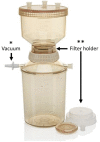Innovative Antibiofilm Smart Surface against Legionella for Water Systems
- PMID: 35630315
- PMCID: PMC9144790
- DOI: 10.3390/microorganisms10050870
Innovative Antibiofilm Smart Surface against Legionella for Water Systems
Abstract
Legionella pneumophila contamination of water systems is a crucial issue for public health. The pathogen is able to persist in water as free-living planktonic bacteria or to grow within biofilms that adhere to and clog filters and pipes in a water system, reducing its lifespan and, in the case of hospital buildings, increasing the risk of nosocomial infections. The implementation of water management is considered to be the main prevention measure and can be achieved from the optimization of water system architecture, notably introducing new materials and strategies to contrast Legionella biofilm proliferation and so prolong the water system functionality. In this research, we propose a new smart surface against L. pneumophila biofilm formation. This is based on an innovative type of coating consisting of a sulfonated pentablock copolymer (s-PBC, commercially named Nexar™) deposited on top of a polypropylene (PP) coupon in a sandwich filter model. The covering of PP with s-PBC results in a more hydrophilic, acid, and negatively charged surface that induces microbial physiological inhibition thereby preventing adhesion and/or proliferation attempts of L. pneumophila prior to the biofilm formation. The antibiofilm property has been investigated by a Zone of Inhibition test and an in vitro biofilm formation analysis. Filtration tests have been performed as representative of possible applications for s-PBC coating. Results are reported and discussed.
Keywords: Legionella pneumophila; biofilm; s-PBC; smart coatings; water safety plan.
Conflict of interest statement
The authors declare no conflict of interest.
Figures






References
-
- Coniglio M.A., Ferrante M., Yassin M.H. Preventing Healthcare-Associated Legionellosis: Results after 3 Years of Continuous Disinfection of Hot Water with Monochloramine and an Effective Water Safety Plan. Int. J. Environ. Res. Public Health. 2018;15:1594. doi: 10.3390/ijerph15081594. - DOI - PMC - PubMed
-
- Committee on Management of Legionella in Water Systems. Water Science and Technology Board. Board on Life Sciences. Board on Population Health and Public Health Practice. Division on Earth and Life Studies. Health and Medicine Division. National Academies of Sciences, Engineering, and Medicine . Management of Legionella in Water Systems. National Academies Press; Washington, DC, USA: 2019. p. 25474. - PubMed
-
- Butler C.S., Boltz J.P. 3.6—Biofilm Processes and Control in Water and Wastewater Treatment. In: Ahuja S., editor. Comprehensive Water Quality and Purification. Elsevier; Waltham, MA, USA: 2014. pp. 90–107.
LinkOut - more resources
Full Text Sources
Miscellaneous

